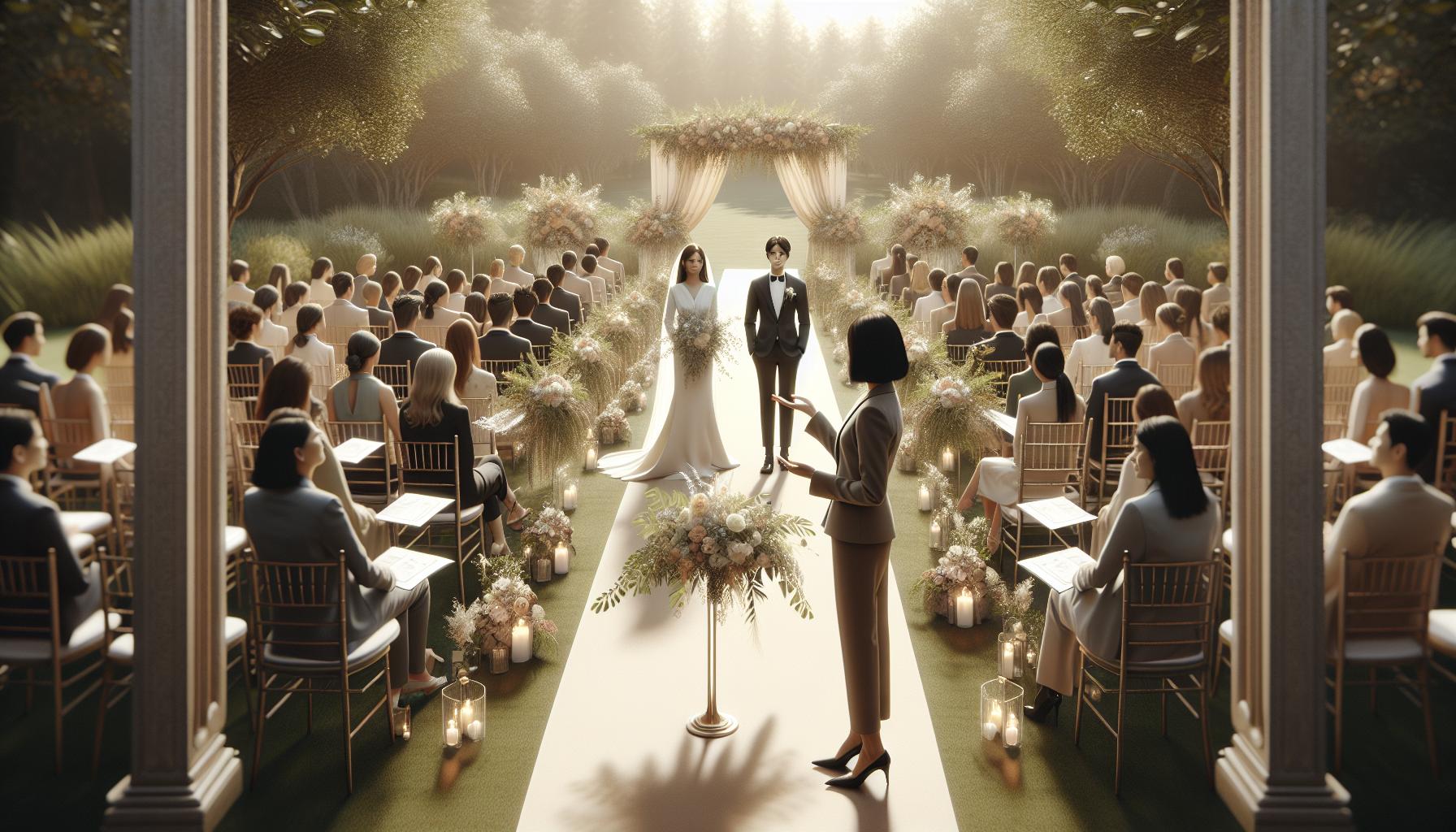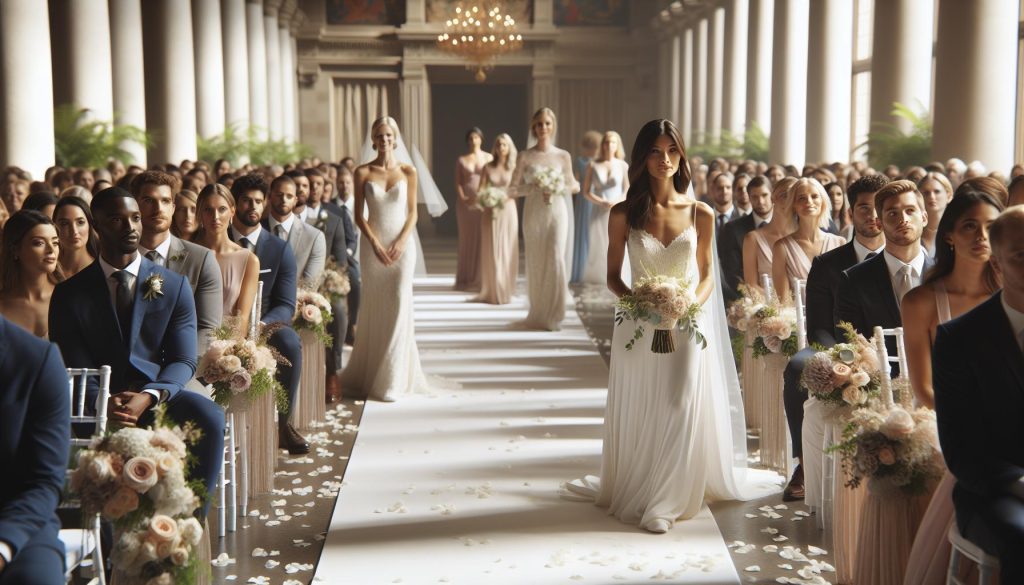As you embark on the beautiful journey of wedding planning, understanding the processional is crucial to creating a memorable ceremony. Did you know that the side of the aisle the bride walks down holds significant meaning in many cultures? It’s not just a detail; it sets the tone for the entire wedding and reflects cherished traditions. This guide will explore the ins and outs of the processional, providing you with valuable insights that cater to your unique vision. By navigating this essential aspect of your big day, you’ll be better equipped to make decisions that resonate with both you and your partner. Whether you’re honoring family customs or crafting your own path, discovering the nuances of the ceremony helps cultivate a deeper connection to your special moment. Join us as we unveil the traditions, etiquette, and personal touches that can make your wedding processional truly unforgettable.
Choosing the Right Side: Tradition vs. Modernity
Choosing the side of the aisle where the bride walks down is a moment steeped in tradition, yet it offers the perfect opportunity to embrace modern interpretations that reflect the couple’s unique journey. Traditionally, the bride walks down the right side while her father stands on the left, symbolizing his role as protector. This age-old custom hints at a time when marriages were more about alliances between families, and the positioning had practical significance. However, today’s weddings encourage personalization that honors both history and individuality.
Couples now have the freedom to choose whatever side they feel best represents their love story. This might mean altering the traditional arrangement to suit personal preferences, cultural backgrounds, or even family dynamics. For instance, in a same-sex wedding, the side choice might hold different meanings, reflecting equality and unity. Additionally, many couples opt for a symmetrical approach, allowing both partners to step down the aisle together, symbolizing their partnership from the outset of their married life.
When contemplating this decision, potential wedding planners should consider not only tradition but also the impact that the chosen side may have on visual elements such as photographs and seating arrangements. Consulting with a wedding coordinator or planner can help to seamlessly integrate these choices into the overall design of the ceremony. Ultimately, the aisle should not just be a path walked but an avenue that resonates with the couple’s essence and the story they want to tell their friends and family on their special day.
Understanding Aisle Etiquette for Weddings
Walking down the aisle is one of the most cherished moments in a wedding, filled with emotion, anticipation, and tradition. Each step symbolizes not only a journey toward lifelong partnership but also upholds an unwritten set of guidelines known as aisle etiquette. Understanding these norms can elevate the ceremony and ensure that everyone involved feels comfortable and respected.
First, it’s vital to establish who walks down the aisle and in what order. Traditionally, family members are honored first before the bride herself makes her grand entrance. This sequence can include the grandparents, parents, and wedding party, each with specific roles. For example, often, the bride’s father escorts her, marking a significant moment in their relationship. However, modern weddings embrace flexibility-some brides walk alone, while others may opt for both parents or a beloved friend to accompany them, highlighting the personal nature of the event.
Another aspect of aisle etiquette is recognizing the importance of positioning. Typically, guests sit on the opposite side of where the bride walks down the aisle. This arrangement not only makes for stunning photographs but also enhances the visual narrative of the ceremony, creating a clear pathway for the couple. It’s essential to communicate with your wedding planner about seating arrangements to ensure a smooth flow during the procession.
Lastly, the atmosphere plays a crucial role in enhancing the moment. Choose music that resonates with your love story to accompany the procession. Whether it’s a live string quartet or a favorite song played through speakers, the right choice can evoke emotion and create lasting memories as you walk toward your future together. By considering these elements of aisle etiquette thoughtfully, couples can craft a memorable and dignified ceremony that reflects their journey and honors their loved ones.
The Role of the Wedding Party in Procession
The wedding party is an integral part of the ceremony, serving not only as support for the couple but also as a dynamic presence that enhances the overall ambiance and flow of the processional. Each member plays a unique role, contributing to the emotional weight of the moment as they walk down the aisle, setting the stage for the couple’s highly anticipated entrance. In this sacred space, the wedding party is not just part of a décor; they embody the love, laughter, and memories that have shaped the couple’s journey.
Typically, the wedding party includes the maid or matron of honor, bridesmaids, best man, groomsmen, and sometimes includes flower girls and ring bearers. Their entrance order is significant and can vary based on personal preference, traditions, or the ceremony’s style. For instance, bridesmaids and groomsmen often walk in pairs, creating a visual balance that captivates guests. Allowing younger family members, such as flower girls and ring bearers, to take part can add an adorable and heartwarming touch, showcasing the joyous unity of family and friends. It’s essential to ensure that everyone understands their specific roles and timing, reducing potential stress and confusion on the big day.
Crafting the Perfect Processional Order
Choosing the right processional order can be a delightful opportunity for personalization. Couples might explore traditional sequences or mix elements that resonate with their relationships and stories. Common arrangements include the procession commencing with the officiant, followed by grandparents, then parents, the wedding party, and ultimately the bride. Alternatively, modern interpretations allow for less formality-imagine a scenario where each couple in the wedding party showcases their unique personalities during their walk, using fun props or coordinating outfits to highlight their bond with the couple.
To avoid common pitfalls, ensure that the wedding party is rehearsed and prepared, familiarizing them with the venue layout. A successful walk down the aisle not only relies on careful planning but also on the chemistry and comfort level of your party members, encouraging them to share the moment authentically. The excitement in their faces will surely enhance the emotional atmosphere as the moment culminates in the entrance of the couple.
In essence, the wedding party’s roles in the procession extend far beyond simply walking down the aisle. They embody goodwill and support, ensuring that this significant occasion is marked by laughter, love, and an inviting warmth that encapsulates the spirit of the celebration. By indulging in the nuances of these roles, couples can create a memorable and breathtaking procession, one that reflects their journey and resonates with every guest present.
Processional Order for Different Wedding Styles
The processional order is more than just a list of who walks when; it’s a visual narrative that reflects the couple’s unique love story and wedding style. Each wedding style calls for a different approach to how your loved ones gather and make their way down the aisle, enhancing the overall mood of the ceremony. For instance, in a traditional wedding, the processional typically includes specific roles: the officiant walks in first, followed by grandparents, parents, the wedding party, and finally the bride. This organized flow provides a sense of formality and dignified rhythm, perfect for churches and more classic venues.
On the other hand, a modern or non-traditional wedding offers complete freedom for couples to be creative with the processional order. For example, a couple might decide to have everyone, including the bride, walk down the aisle together, symbolizing unity and equality. Alternatively, you could choose to have members of the wedding party enter in pairs or walk individually-this fosters a more relaxed and personal atmosphere, especially suited to outdoor or casual settings. Each choice sends its own message, allowing couples to express their personalities as they embrace the day’s emotions.
Celebrating cultural traditions can also play a significant role in determining processional orders. For instance, in many cultures, special rituals might dictate the order, such as having parents or elders walk the couple down the aisle as a sign of blessing and community support. Incorporating unique elements like live musicians, or even having family members share stories or introduce their loved ones before they walk, cultivates a sense of closeness and warmth, making the event feel intimate and memorable.
Ultimately, no matter the chosen style, consider what feels right for you as a couple. The goal is to create an experience that resonates with both your love story and the significance of the moment, remaining flexible and open to make adjustments as needed. This journey is about celebrating the connections that matter most, ensuring that each step down the aisle is filled with joy, support, and love.
Cultural Variations in Aisle Walking
While wedding traditions often emphasize a specific sequence for the processional order, cultural variations can offer couples beautiful opportunities to infuse their heritage into their ceremonies. Understanding how differing cultures approach the aisle walk can enrich the wedding experience, making it a more meaningful reflection of the couple’s backgrounds.
In many Western cultures, the bride traditionally walks down the aisle from the back toward the altar. However, this can vary dramatically in other cultures. For example, in some African traditions, the bride may be escorted down the aisle by her father, but she may also pause at designated spots to honor her ancestors with ritual gestures or songs. This moment enhances the spiritual connection of the ceremony by weaving together family legacy and modern love.
Similarly, in Chinese weddings, the couple often participates in a “Guo Da Li” ceremony before the wedding day, where gifts are exchanged between families. This can set a distinctly different atmosphere for the aisle processional itself, with family members playing an integral role in the couple’s entrance, which demonstrates respect and community. In contrast, some South Asian weddings see the groom entering the venue first, accompanied by his family in a vibrant procession called the “Baraat,” while the bride awaits in another location. When she walks down the aisle, she does so amidst significant cultural celebrations that culminate in her union with her partner.
Traditional Jewish weddings incorporate the “Kabbalat Panim” where both the bride and groom are celebrated separately before the ceremony. The bride walks to the chuppah (wedding canopy) often escorted by both parents, symbolizing their blessings and support. This engagement not only sets a celebratory tone but also reinforces family bonds, accentuating the collective love that envelops the couple.
Ultimately, couples should feel encouraged to tailor their processional to honor their cultural practices while also reflecting their personal values and story. Whether it’s through selective rituals, music choices, or how they choose to walk down the aisle, integrating cultural nuances can create heartfelt, memorable moments that could not only resonate with the couple’s identity but also foster a deeper connection with their guests. Embrace this opportunity for expression, and let every step down the aisle symbolize not just a union of two lives, but a beautiful merging of traditions and families.
Tips for Personalizing Your Processional
Crafting a personal and memorable processional can transform the entrance experience into one that is uniquely yours. With each step down the aisle, you have the chance to infuse your personality, values, and cultural heritage into the ceremony. To achieve this, consider various elements that reflect your style, from music choices to the way you include family and friends.
One way to personalize your processional is through music. Think beyond traditional wedding marches; choose a song that holds significance for you as a couple. Whether it’s the first tune you danced to or a melody that reminds you of a shared moment, this decision can evoke deep emotions and set a beautiful tone for your entrance. Additionally, consider live musicians or a special arrangement to elevate the atmosphere.
The role of your wedding party can also serve as a canvas for personalization. Involve them in the sequence and functions. For example, if close friends or family members have a special talent, such as singing or playing an instrument, invite them to participate during the processional. You could also assign specific roles that resonate with your relationship, such as having your siblings lead the way or if children are part of your lives, a special entrance for them can add sweetness and charm.
It’s essential to respect family traditions while also forging your own path. Incorporating rituals or practices from your respective cultures can make the event richer. For instance, if one of you has a tradition of presenting flowers at a certain point in the ceremony, consider how this can be melded into the processional. Engage your families in these discussions; it can create inclusive moments that resonate deeply with everyone present.
Don’t overlook the importance of visual elements-flower petals, banners, or unique attire can enhance the personal touch. When walking down the aisle, consider the use of colors or fabrics that represent your heritage or are simply significant to you both. Practical elements, like mood lighting or a beautifully arranged aisle, can elevate the overall effect, ensuring that every detail is aligned with your vision.
Ultimately, this moment is about celebrating you as a couple. Allow your story to shine through in each carefully chosen detail and let your processional be a heartfelt reflection of your love, unity, and the lives you are merging together.
Common Mistakes to Avoid During the Processional
A beautifully orchestrated processional sets the tone for the entire wedding ceremony, but there are several common pitfalls to be mindful of to ensure that everything goes smoothly. One of the most significant mistakes couples can make is underestimating the importance of rehearsal. Skipping this critical step can lead to confusion on the day of the ceremony, particularly regarding the order of entrance and specific roles. Gather your wedding party and practice walking down the aisle multiple times to familiarize everyone with their entries, as well as the timing with music and cues.
Another frequent error is neglecting to communicate essential details to family and close friends involved in the processional. Clear instructions regarding who walks where, and when can eliminate uncertainty and anxiety. For instance, if you have chosen to include special family members, ensure they are aware of their roles and have practiced adequately. It’s also crucial to have a designated person, like a wedding coordinator or a trusted friend, to help guide everyone on the day of the event, keeping the processional organized and stress-free.
Additionally, failing to consider the timing of the music can significantly impact the emotional atmosphere of the moment. A common mistake is either starting the music too late or too early, leading to awkward gaps or rushed entrances. Coordinate with your musicians or DJ to ensure they know when to begin playing, and consider timing it with the arrival of key individuals, such as the bride or wedding party.
Lastly, be cautious not to overfill the processional. While it can be tempting to have many loved ones join in, this can create a crowded or chaotic experience. Aim for a well-thought-out procession that reflects your vision, keeping it intimate while honoring significant people in your lives. Streamlining your processional not only allows for a more poignant moment but also makes it easier for your guests to engage with each step of your journey down the aisle. By avoiding these common mistakes, you can create a memorable entrance filled with love, joy, and seamless celebration.
Incorporating Family Traditions into Your Walk
In the enchanting journey of a wedding processional, the act of walking down the aisle can be imbued with rich family traditions that honor your heritage and create a deeper connection to your past. Embracing these traditions not only adds a layer of personal significance but also cultivates a poignant moment that resonates with your loved ones and enhances the overall ceremony.
To weave family traditions into your processional, first consider the unique customs your families cherish. These might include having a parent or grandparent escort you, a family heirloom tied to your attire, or even a specific song that holds special memories. Emphasizing these elements not only honors the beloved figures in your life but also helps you create a narrative that intertwines your histories. For example, if your family has a tradition of walking down the aisle together, discuss this with your parents or siblings to see how you can incorporate this into your entrance, perhaps by having them join you partway down the aisle or standing with you at the altar.
Connecting Generations
Think creatively about how to represent your family lineage during the procession. You could also consider incorporating cultural elements, such as traditional attire or rituals from your respective backgrounds. Perhaps there’s a song from your culture that symbolizes love and unity, or a dance that could be included as you make your way down the aisle. Such choices not only personalize your processional but also beautifully highlight the melding of two families and cultures, creating a shared experience for everyone in attendance.
When it comes to communicating these family traditions to your wedding party or officiant, clarity is key. Gather everyone involved in the processional and ensure they understand their roles-from the special way family members will participate to any significant items that will be carried or worn. This preparation cultivates a seamless flow and allows everyone to embrace the moment fully, enriching the emotional resonance of the ceremony.
Integrating family traditions into your walk down the aisle ultimately elevates the significance of your wedding day, transforming a simple act into a heartfelt tribute to those who have shaped your life. As you plan this memorable entrance, consider the love, history, and joy that these elements bring, making it a cherished moment that you and your loved ones will hold close to your hearts for years to come.
How to Communicate Roles and Responsibilities
Planning the processional for your wedding is a captivating part of the ceremony that sets the tone for the entire event. To ensure a seamless experience, clear communication about roles and responsibilities among all participants is essential. Not only does this foster a sense of confidence, but it also creates an atmosphere in which everyone feels celebrated and valued.
Begin by organizing a meeting with your wedding party, family, and any other key individuals involved in the processional, such as parents or special guests. During this gathering, outline the specific order of events and clarify who will be walking where. Provide a visual aid, such as a flowchart or a diagram, to illustrate the procession. This can help everyone visualize their roles and grasp the overall flow of the moment. For example, you might outline that the groom’s party will enter first, followed by bridesmaids, and finally the bride herself.
Detailing Each Role
Make sure to explain the significance of each role, whether it’s carrying flowers, holding family heirlooms, or simply being there to provide emotional support. Encourage each participant to ask questions if they have any uncertainties, as this dialogue will foster trust and clarity. For instance, if someone is escorting the bride, reassure them about the timing of their entrance, and provide guidance on how to walk together down the aisle gracefully.
Furthermore, as the wedding day approaches, consider a rehearsal to practice the processional. During this rehearsal, everyone can familiarize themselves with the layout of the venue and the specifics of their entry timing. It’s an excellent opportunity to discuss any last-minute adjustments in a relaxed setting. As part of this practice, remind everyone to focus on maintaining their composure and enjoying the moment, as this is just as important as knowing the procedures.
By nurturing clear communication and reinforcing the importance of each individual’s role, your processional can transform from a mere logistical detail into a heartfelt occasion filled with love and connection. Every person standing at the altar with you will contribute to the warmth of the ceremony, making it a truly memorable celebration for everyone involved.
Rehearsal Tips for a Smooth Processional
The journey down the aisle is a moment etched in time, filled with emotion and anticipation. To ensure this pivotal part of your wedding day flows seamlessly, rehearsing the processional is essential. This practice not only familiarizes everyone with their roles but also allows for any adjustments to be made while alleviating last-minute nerves.
Start by choosing a location and time that allows all key participants to be present. Ideally, conduct the rehearsal at the actual venue, as this helps everyone visualize the setup and dynamics of the space. During the rehearsal, walk through the entire processional step by step. It’s beneficial to demonstrate the timing and pacing – for example, practicing how slowly to walk and when to pause for dramatic effect. Remind everyone to maintain a sense of grace and poise, encouraging a few tips on posture and eye contact with the audience, which adds to the emotional depth of the moment.
Encourage your wedding party and family members to communicate openly during the rehearsal. If someone has a concern or uncertainty about where to stand or how to enter, address it together. This not only builds confidence but also strengthens bonds among the participants. Create an atmosphere of celebration, turning rehearsal time into a shared experience of joy. Invite laughter and lighthearted moments; this will create a positive memory associated with the processional.
Finally, consider designating a person to cue the music and maintain the rhythm during the actual ceremony. Having someone responsible for these details helps keep everyone synchronized when the time comes. As you lead up to the big day, reinforce to every participant how truly special this moment is. It’s their chance to shine and support you, ensuring the aisle walk becomes a cherished memory for everyone involved.
Enhancing the Moment: Music and Atmosphere
The right music and atmosphere can transform the moment of your wedding processional into an unforgettable experience. Picture this: the soft, harmonious notes start to play, each one echoing the emotions of love and commitment, wrapping your guests in a warm embrace as you glide down the aisle. Choosing the right processional song is not just about personal preference but can enhance the deep symbolic significance of this moment. Whether you opt for classical pieces like *Canon in D* or a more contemporary track that resonates with your love story, the song sets the mood and tone for your ceremony.
Creating the ideal atmosphere involves more than just selecting music; consider how lighting, flowers, and decor can work together to elevate the experience. Soft, dim lighting or candle arrangements can create an enchanting backdrop, while the scent of fresh flowers can add an extra layer of sensory excitement. Think about your venue as well-is it an open garden filled with natural light, or a cozy indoor space? Each setting offers a unique opportunity to personalize the ambiance. Discuss with your wedding planner or venue coordinator about options for draping fabric, utilizing up-lighting, or incorporating floral arrangements that align with your color palette.
Creating a seamless integration between the music and the visual elements is crucial. To help maintain the desired mood throughout the processional, you could arrange for a designated person to cue the music at the precise moment individuals enter the venue. This coordination will ensure the energy builds appropriately, making the moment feel cohesive and intentional. Don’t forget the importance of your guests’ experience as well; ideally, they should feel the anticipation and excitement right alongside you. Arrange for a consistent visual path that speaks to your wedding theme, whether it’s a flower petal-strewn aisle or lanterns marking the way, so everyone feels enveloped in the magic of your day.
Think about how these elements work together. Here are some tips to keep in mind:
- Song Selection: Choose a piece that reflects both your personalities and relationship.
- Lighting: Use soft, warm lights or candles to create a welcoming atmosphere.
- Visual Path: Consider your aisle decorations carefully, ensuring they align with the ceremony’s overall aesthetic.
- Communication: Make sure the person responsible for music cues understands the flow and timing.
- Rehearsal: Practice the walk with music to ensure everyone is comfortable with timing.
By thoughtfully curating these elements, you set the stage for an emotionally resonant moment that you and your guests will remember forever, establishing the framework for a beautiful ceremony that celebrates your love.
Creating an Inclusive Aisle Experience for All
Walking down the aisle is not only a pivotal moment for the couple but also a shared experience that invites all guests to participate in the celebration of love. Creating an inclusive aisle experience ensures that every attendee-regardless of age, mobility, or cultural background-feels welcome and engaged. Consider ways to design your processional to accommodate everyone while honoring the significance of the occasion.
Begin by evaluating your venue for accessibility. Ensure that pathways are clear and wide enough for guests with mobility challenges, and consider design elements like ramps if there are steps involved. Inform guests ahead of time about the layout, noting any features that may be relevant for those needing assistance, so they feel prepared and comfortable navigating the space. Additionally, think about seating arrangements; ideally, the front rows should be accessible to family members who might need a clearer view.
The music and atmosphere also play a crucial role in creating inclusivity. Opt for songs that resonate across cultures and backgrounds, incorporating varied musical styles if your family or your fiancé’s family comes from diverse traditions. This mutual appreciation not only sets a joyous tone but also acknowledges the rich tapestry of relationships represented at your ceremony. You might even consider a multicultural element to your processional, like starting with one family member’s favorite song before transitioning into your chosen piece as you walk down the aisle, engaging guests on multiple levels.
As you prepare your processional order, reflect on the roles of everyone involved. Provide each participant with clear instructions on their positions and actions, ensuring they understand the timings. Visual cues, such as signs or lighting effects, can help guests stay oriented. Finally, during your rehearsal, prioritize practicing with the entire wedding party so everyone feels confident. This shared experience not only smooths out potential kinks but also fosters a sense of unity and excitement that can be felt throughout the gathering.
By focusing on these elements, you’re fostering an atmosphere where every guest feels acknowledged and valued, making the shared moment of walking down the aisle even more memorable for all involved.
Q&A
Q: What side does the bride traditionally walk down the aisle?
A: Traditionally, the bride walks down the left side of the aisle. This custom dates back to when the groom would use his right hand to draw his sword to protect the bride as they walked together, leaving his left side open for her.
Q: Can the bride walk down the right side of the aisle?
A: Yes, the bride can walk down the right side of the aisle if she prefers. Modern weddings often allow couples to choose their own traditions, and many opt for personal significance over traditional norms.
Q: What are common processional roles in the wedding ceremony?
A: Common roles during the wedding processional include the officiant, bridesmaids, groomsmen, flower girl, ring bearer, and the bride. Each participant has a designated order, often outlined in the wedding planning guide to ensure a smooth entrance.
Q: How can cultural variations affect the bride’s aisle direction?
A: Cultural variations can influence which side of the aisle the bride walks down. For instance, in some cultures, the bride may walk in a specific pattern or direction that aligns with local customs, showcasing the importance of understanding each tradition.
Q: Should wedding rehearsals include the processional order?
A: Yes, wedding rehearsals should definitely include the processional order. This practice helps everyone understand their roles, timing, and placement for the ceremony, ensuring a seamless experience on the big day.
Q: What music should accompany the bride’s processional?
A: Choosing music for the bride’s processional depends on personal taste. Common choices range from classical compositions to modern love songs, setting the tone for the ceremony. Consider songs that are meaningful to the couple for a personalized touch.
Q: How can couples personalize their processional?
A: Couples can personalize their processional by selecting unique music, incorporating family traditions, or even varying the order of attendees. Personal elements reflect the couple’s journey and create a memorable experience for everyone involved.
Q: What should couples avoid during the wedding processional?
A: Couples should avoid rushing down the aisle or skipping rehearsal. A lack of preparation can lead to confusion and stress. Practicing ensures that each participant is clear on their roles, enhancing the emotional impact of the processional.
For more insights and a deeper understanding of processional etiquette and guidance, explore our sections on Aisle Etiquette and Tips for Personalizing Your Processional.
In Summary
As you plan your dream wedding, remember that choosing which side of the aisle the bride walks down holds symbolic significance, adding to the richness of your ceremony. Embrace this moment-the start of your beautiful journey together-and ensure every detail reflects your unique love story. If you’re eager to dive deeper into wedding planning, explore our guides on processional order and wedding etiquette to enhance your ceremony experience.
Don’t miss out on helpful resources that can ease your planning process! Check out our checklist for seamless wedding prep and tips for selecting the perfect vendors. Join our community by signing up for our newsletter for more valuable insights and inspiration. Your dream wedding is just a few thoughtful decisions away-let’s make it unforgettable!











